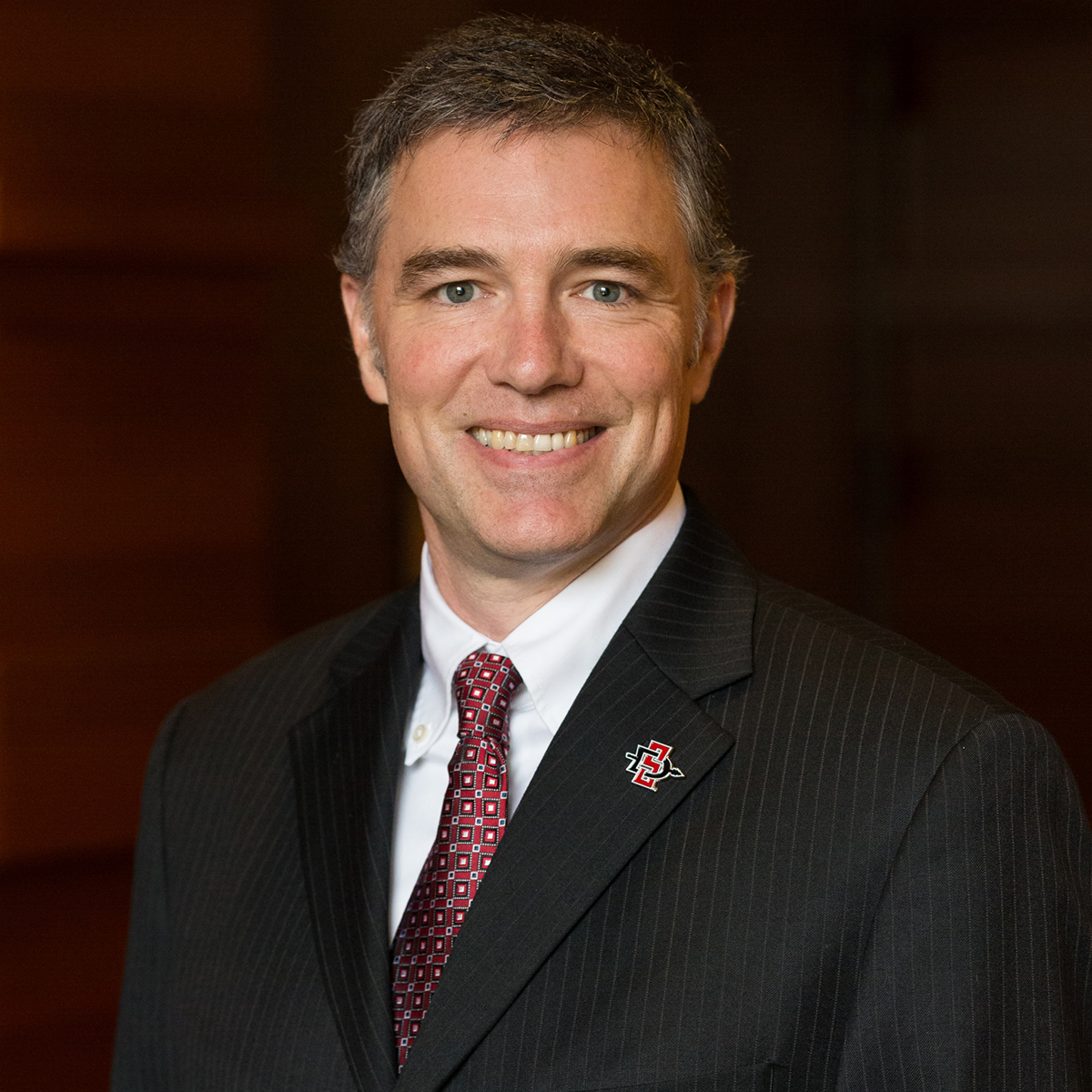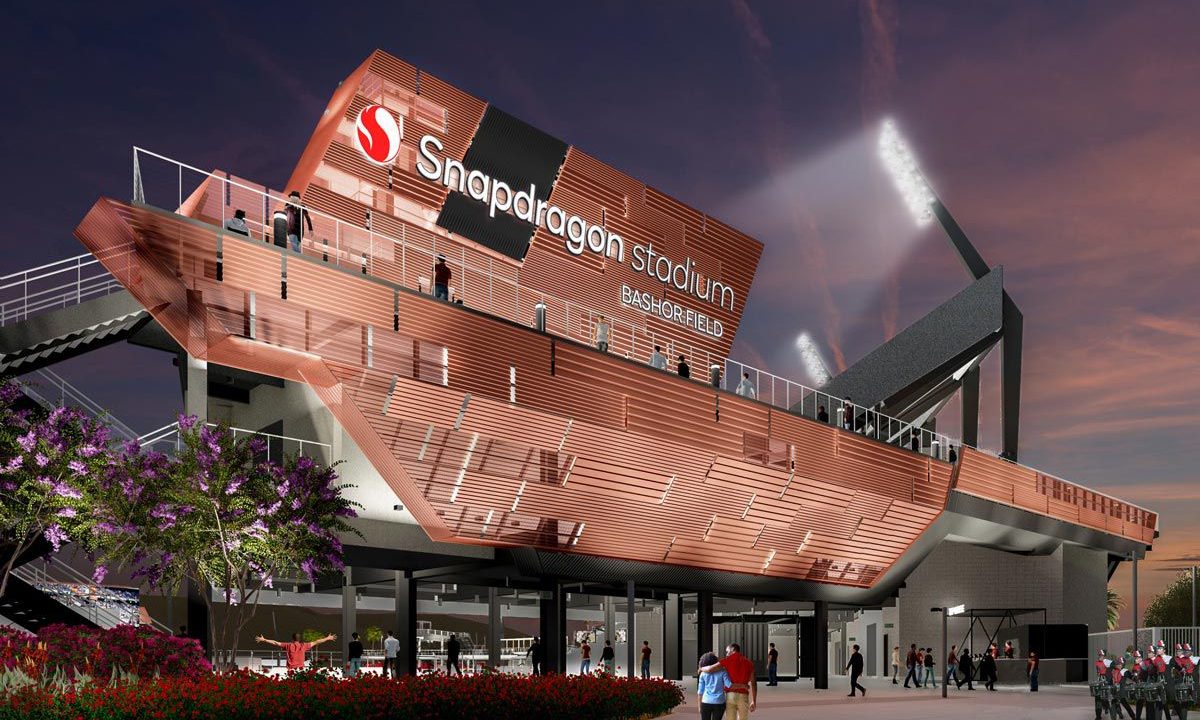SVG Sit-Down: San Diego State University’s John David Wicker Previews the New Snapdragon Stadium
The $310 million, 35,000-capacity venue is projected to host more than 300 events annually
Story Highlights
Constructing and opening a new stadium isn’t common in collegiate sports; many programs normally renovate an existing facility. For San Diego State University (SDSU), though, the situation is very different. A member of the Mountain West Conference, the Aztecs’ football program will be making a statement this fall with the opening of Snapdragon Stadium — a $310 million, 35,000-capacity venue on the 166-acre campus.
At the helm of the project is Director, Intercollegiate Athletics, John David Wicker. In his current role since 2016, he had previously been with SDSU from 2011 to ’15, responsible for the day-to-day operations of the Aztecs athletics department, including video and sport oversight for football, rowing, and men’s and women’s basketball. Before returning to SDSU, he had spent a year as senior athletic director, operations, at Georgia Tech. Wicker also was associate athletic director, event and facility operations, at Washington State from 2001 to ’11, handling event-planning and game-day responsibilities for all home athletic events, conference tournaments, and NCAA championships. From 1999 to 2001, he served as director, event and facility operations, at Southern Miss, overseeing regular-season and championship-event operations, amongst other duties.
SVG caught up with Wicker to discuss what it takes to put a new stadium together, how his career experience benefits the project, how he works with his colleagues to find the correct solutions, and more.
How do you go about choosing the correct technology and equipment for a new collegiate football stadium?
We’re fortunate because we’re coming from a stadium that had [antiquated] technology. There was a game back in 2017 where it rained for about 20 minutes before kickoff, and it was so cold that we lost our main game clock for the game. Heading into this build, we sat down and asked ourselves what people are doing and what technology is best-in-class right now. We didn’t want to go with the biggest videoboard in the Mountain West, because we wanted to spread our money out effectively, but we have 1,600 sq. ft. of LED with two main [displays], boards in the red zone, and boards in the end zone.

SDSU’s John David Wicker heads the Snapdragon Stadium project.
Installing a high-quality videoboard and LED displays can take any game-day atmosphere to the next level. How does this addition enhance the in-person experience?
We’re competing with someone’s 80-in. screen where they can sit on their couch, go to their refrigerator, and be comfortable at home. We wanted to install the best videoboard that looks like your TV at home but also provide the entire experience with content that fans can’t get anywhere else. It was very important to figure out how to keep people coming [to the venue] by serving great social experiences throughout the stadium. Doing all of this from scratch was huge because we weren’t constrained by our old building or space.
Did you gain any inspiration from other sports venues or friends in the industry?
Bank of California Stadium, where LAFC plays, provided a lot of inspiration. Sporting KC’s Children’s Mercy Park was another place where our team first saw the intimacy of an MLS building. It’s smaller than what we’re building, but we’re not going with the traditional collegiate-sports seating because we’re hosting more soccer [and other events]. How steep and intimate our building is we took from seeing other facilities. We also learned that having social spaces is what you need in today’s sports landscape. Since we’re in San Diego, we’re able to take advantage of the climate and build a lot of outdoor areas that are going to help us drive people to the game and monetize the building on non-game days. We took a lot of inspiration from [San Diego Padres’] Petco Park with what they’re doing with food, beverage, and social spaces as well.
We’ve learned from Director of Athletics, Sport Administrator, Football Joe Parker and the folks at Colorado State because they had one of the last new builds in college sports. We toured Colorado State five or six times, and they were always very gracious with the information.

The first home game at Snapdragon Stadium will be Saturday, Sept. 3 vs. Arizona.
What aspects of the stadium excite you for its opening?
We’re the only football/soccer stadium in the city, and we’re not competing with anybody in that space. But, when I spoke with [design and architecture firm] Gensler, I wanted a venue that was 60% stadium and 40% San Diego. There are seats, concessions, and all of the other elements that go into a typical stadium, but we also figured out what the beauty shots were going to be. We’ve developed something called The Piers, which take inspiration from the Pacific coastline. We’ll have three levels of elevated standing-room-only space, with low-box seating on the front edge of two of the piers and the third pier going out into the seating bowl at the southwest corner of the building. That’s going to be the space that everybody’s going to want to be in. We’ve also specifically designed this stadium to put food trucks in the northeast corner for every event. If you wanted to, you could rent the space for a concert because you can put a thousand people in there.
How does your experience with in-venue production play a factor in your current role?
I used to sit in my office at Georgia Tech and told myself that, if I ever get the chance to build a building, I’m never going to build something that we can’t use 365 days a year. I’ve done a stadium remodel, but everybody dreams of being able to build your own venue from scratch. I don’t get nearly as much time to get into the weeds and in the minutia of [the day-to-day], but it definitely helped as we started thinking about the elements that we wanted in the stadium and how we wanted the stadium to run. The fun part is being able to say that I know how a stadium runs.

The main videoboard will highlight the 1,600 sq. ft. of LED display in the venue.
Are there any shoutouts you’d like to give to members of your team?
Executive Associate Athletic Director, Mission Valley Development, Derek Grice definitely deserves a shoutout. I had hired him at Georgia Tech when I was there. Then, when we got this opportunity, Derek has a good background in building facilities. He has been the guy who has been leading the charge from the Athletic Department side; we wouldn’t be where we are today without Derek.
This interview has been edited for length and clarity.
